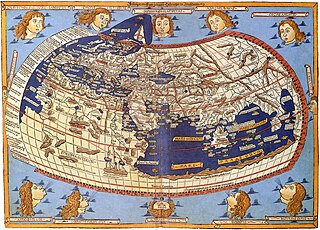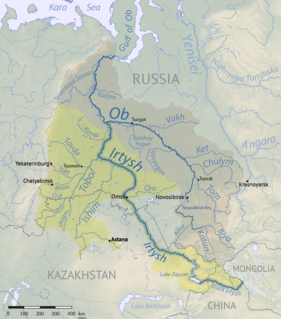
Cartography is the study and practice of making and using maps. Combining science, aesthetics and technique, cartography builds on the premise that reality can be modeled in ways that communicate spatial information effectively.

Siberia is an extensive geographical region, constituting all of North Asia, from the Ural Mountains in the west to the Pacific Ocean in the east. It has been a part of Russia since the latter half of the 16th century, after the Russians conquered lands east of the Ural Mountains. Siberia is vast and sparsely populated, covering an area of over 13.1 million square kilometres (5,100,000 sq mi), but home to merely one-fifth of Russia's population. Novosibirsk and Omsk are the largest cities in the region.

The Irtysh is a river in Russia, China, and Kazakhstan. It is the chief tributary of the Ob and is also the longest tributary river in the world.

Borís Fyodorovich Godunóv ruled the Tsardom of Russia as de facto regent from c. 1585 to 1598 and then as the first non-Rurikid tsar from 1598 to 1605. After the end of his reign, Russia descended into the Time of Troubles.

Avvakum Petrov was a Russian protopope of the Kazan Cathedral on Red Square who led the opposition to Patriarch Nikon's reforms of the Russian Orthodox Church. His autobiography and letters to the tsar, Boyarynya Morozova, and other Old Believers are considered masterpieces of 17th-century Russian literature.

Tobolsk is a town in Tyumen Oblast, Russia, located at the confluence of the Tobol and Irtysh rivers. Founded in 1590, Tobolsk is the second-oldest Russian settlement east of the Ural Mountains in Asian Russia, and is a historic capital of the Siberia region. Population: 99,694 (2010 Census); 92,880 (2002 Census); 94,143 (1989 Census).

Yermak Timofeyevich was a Cossack ataman and is today a hero in Russian folklore and myths. In the reign of Tsar Ivan the Terrible Yermak started the Russian conquest of Siberia.

Joseph-Nicolas Delisle was a French astronomer and cartographer.
Godunov is a Russian surname.

Pyotr Pavlovich Yershov was a Russian poet and author of the famous fairy-tale poem The Little Humpbacked Horse (Konyok-Gorbunok).

Philip Johan von Strahlenberg (1676–1747) was a Swedish officer and geographer of German origin who made important contributions to the cartography of Russia.
Juraj Križanić, also known as Jurij Križanič or Yuriy Krizhanich, was a Croatian Catholic missionary who is often regarded as the earliest recorded pan-Slavist. His ideal, often misunderstood - even today - was to bring about a union of the churches, which Rome and Constantinople had tried to do without success for centuries. He believed that this might come about through closer relations between Slav Catholicism and the Russian Orthodox Church, and supported the idea that all Slavs had a common language and ethnic origin.

The Tsardom of Russia or Tsardom of Rus', also externally referenced as the Tsardom of Muscovy, was the centralized Russian state from the assumption of the title of Tsar by Ivan IV in 1547 until the foundation of the Russian Empire by Peter I in 1721.

The Russian conquest of Siberia took place in the 16th and 17th centuries, when the Khanate of Sibir became a loose political structure of vassalages that were being undermined by the activities of Russian explorers. Although outnumbered, the Russians pressured the various family-based tribes into changing their loyalties and establishing distant forts from which they conducted raids. To counter this, Kuchum Khan attempted to centralize his rule by imposing Islam on his subjects and reforming his tax-collecting apparatus.

The Great Northern Expedition or Second Kamchatka expedition was one of the largest exploration enterprises in history, mapping most of the Arctic coast of Siberia and some parts of the North American coastline, greatly reducing "white areas" on maps. It was conceived by Russian Emperor Peter the Great, but implemented by Russian Empresses Anna and Elizabeth. The main organiser and leader of the expedition was Vitus Bering, who earlier had been commissioned by Peter I to lead the First Kamchatka expedition. The Second Kamchatka Expedition lasted roughly from 1733 to 1743 and later was called the Great Northern Expedition due to the immense scale of its achievements.

Fritz Cronman was a Major for the Swedish Empire in the late 17th century, and the Swedish diplomat to the Tsardom of Russia from 1668 to 1669. His extant diary and letters contain detailed information on the court of Ivan V of Russia.

Semyon Ulyanovich Remezov was a Russian historian, architect and geographer of Siberia. He is responsible for compiling three collections of maps, charts and drawings of Siberia, which effectively became atlases of the area. Remezov's atlases were important to Peter the Great's imperial expansion into the eastern territory of Russia as they provided the Tsar with information on the Siberian landscape and the location of its indigenous communities. Such knowledge became necessary for future administrative and military projects in the area.
Daniel Gottlieb Messerschmidt was a German physician, naturalist and geographer and among the first to conduct a scientific exploration of Siberia, which led to the unearthing of the first fossil mammoth.

Pyotr Ivanovich Godunov was the Governor-General of Western Siberia as the Voevoda in Tobolsk from 1667 until his death in 1670, before which he had been a steward (стольник) in the tsar’s court.

The Principality of Kod, or the Principality of Koda (Кода), was a Khanty principality located in north Western Siberia from the 15th to 17th century. It was located on both banks of the Ob River and along the river tributaries of Kazym and Irtysh, occupying an area approximately now the Oktyabrsky District of the Khanty-Mansi Autonomous Okrug. The rulers of Kod, the House of Alachev, had in their possession various fortified towns along the banks of the Ob, the largest of which being the capital of Shorkar, later Alachev. Kod was generally allies of the Grand Duchy of Moscow, and later the Tsardom of Russia, engaging in conflicts with other Yugra states like the Principality of Pelym, though occasionally also siding with enemies of Moscow, like Kuchum Khan of the Sibir Khanate or rebel Ivan Bolotnikov. The principality was ultimately annexed into the expanding Russian state in 1643.

















